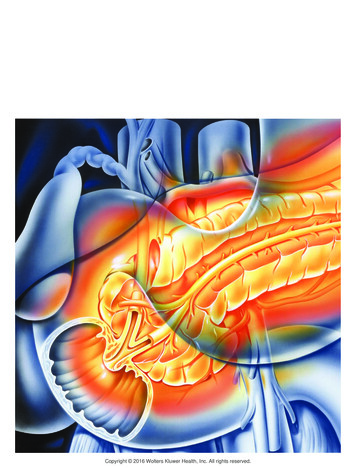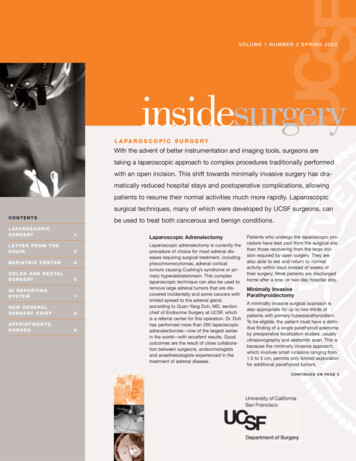
Transcription
Volume 11, Number 1, 2018. pp. 45-58Jordan Journal of PhysicsARTICLEAdvancing Nuclear Astrophysics UsingNext-Generation Facilities and DevicesaaabaC. Langer , N. Klapper , C. Köppchen , S. Dababneh and R. ReifarthabGoethe University Frankfurt, Frankfurt, Germany.Department of Physics, Faculty of Science, Al-Balqa Applied University, Salt, Jordan.Received on: 23/8/2017;Accepted on: 18/12/2017Abstract: Where are all the heavy elements formed? How are they formed? What is therole played by stars and stellar explosions?Nuclear astrophysics aims at answering these fundamental scientific questions by linkingnuclear physics with astrophysical modelling and observations. Large progress has beenachieved in past decades. However, new nuclear physics facilities and devices are urgentlyrequired to advance research into regions of the nuclear chart so far not reachable. This willenable unprecedented studies of nuclear reactions in the laboratories, which are key forheavy element synthesis and the fate of a star. Some highlights of upgrade-in-process willbe described.Experimental effort needs to be guided by astrophysical modelling to find significantuncertainties and pinpoint important measurements to be carried out. For two astrophysicalscenarios, sensitivity studies using detailed nuclear network calculations will be presented.These calculations involve charge-particle induced reactions like (p, ) or ( , ) during therapid proton capture process (rp process). On the other hand, core-collapse supernovae canbe studied using rare presolar type C SiC grains. Observed peculiar abundance distributionsin these grains can be explained with the conditions during the nucleosynthesis. Wetherefore study the light mass Si-S region by variations of (n, ) reaction rates. Also, theinfluence of different neutron pulses and the effect on the final abundances of theproduction of the important radioisotope 32Si are examined.Both investigations stress the need for enhanced experimental approaches to measurereaction rates to better constrain the astrophysical sites.Keywords: Nuclear astrophysics, Presolar grains, Nuclear physics, Facilities, Networkcalculations.IntroductionNuclear reactions play a dominant role for theenergy generation of stars. Fusion reactionsduring the hydrostatic evolutionary phases of astar lead to a partial creation of heavy chemicalelements up to iron-like elements [1,2].Elements beyond iron must be produced inother processes. In a ground-breakingpublication [3], the authors describe severalprocesses involving particle captures on existingseed nuclei for creating the heaviest observedCorresponding Author: Christoph Langerelements. Up to now, our understanding is stillbased on the same idea: all heavy elements mustbe created in stars and stellar explosions.However, the fine details of the differentproduction mechanisms have been shaped andchanged over the past 50 years and it seems thatthe grand picture is settled, see e.g. [4–8].To create heavy elements, several distinctprocesses act in our surrounding universe, likethe slow and rapid neutron capture processes (sEmail: langer@iap.uni-frankfurt.de
ArticleLanger et al.and r-process) at different stellar sites. Inputfrom nuclear physics, like cross-sections,reaction rates, masses, binding energies, halflives and others, are key for understanding thedetails of these production mechanisms. Forstable or close-to-stable isotopes, many of therequired properties have been determined andcan be used in astrophysical modelling andgalactical chemical evolution calculations [9].involving the very short-lived isotopes relevantfor stellar modelling, which, in turn, will alsolead to a highly-increased understanding of thedetails of how a nucleus arranges and what theunderlying forces are. This is complemented byvery active research in nuclear theory and aconstant increase in computer power, which inturn enables calculations from first principleseven for heavier isotopes, see e.g. [10].However, several heavy element productionprocesses involve highly radioactive isotopes faroff the valley of stability. To study themexperimentally, special radioactive sciencefacilities are required for production of shortlived isotopes as a beam. It is then possible toexamine relevant astrophysical reactions;however, many measurements still need to becarried out and are urgently required foradvancing astrophysical calculation. Currently,the limitation of existing facilities is reached andfurther progress is hampered. Therefore, majorupgrades are foreseen at several facilities all overthe world.A good overview of ongoing upgrades andfuture facilities can be found e.g. here [11–23].To guide upcoming experiments towards theimportant, so far inaccessible, reactions, detailedastrophysical and nuclear calculations arerequired. Nuclear network calculations can beused to better understand abundance flows anduncertainties in input parameters, like reactionrates and masses, and disentangle them fromthermodynamic effects imposed by the specificastrophysical environment.The next section of this article will shortlymotivate the need for new and upgradedfacilities and devices. All the experimental effortshouldbeguidedbycomprehensiveastrophysical calculations. Therefore, detailednetwork calculations for the rapid proton captureprocess on neutron stars are shown. Also, theinfluence of uncertain reaction rates on arecently discovered peculiarity in the expectedabundance distribution extracted from presolarSiC grains will be discussed and first preliminaryresults will be shown. This potentially leads to abetter understanding of core-collapse supernovaeand their contribution to the formation of SiCgrains.Future Facilities and DevicesMajor upgrades are foreseen at currentfacilities. The focus is on producing more exoticisotopes at higher intensities and better quality.This will finally enable experimental studies46Besides establishing upgraded beam facilities,major effort is also put into the development ofnew equipment and devices relevant for nuclearastrophysics. Next-generation setups, like e.g.the R3 B setup [24,25] and CRYRING atFAIR [26], as well as SECAR [27] and the highrigidity spectrometer at FRIB [28], are extremelyimportant tools for studying processes significantin nuclear astrophysics. They will allow for amultitude of different reaction studies withwhich key properties, like reaction rates andmasses, can be extracted, even with lowestintensity beams.Also, new devices will unfold their fullpotential once the desired upgrades aresuccessfully completed. As an example, it hasbeen shown recently that -ray detection devices,like GRETA [29,30] (similar to AGATA [31])are very powerful instruments for studies relatedto nuclear astrophysics [32–36]. Using them inconjunction with a magnetic spectrometer and aradioactive beam facility, nuclear structureproperties can be extracted, that are in turnsensitively entering the reaction rates.Network CalculationsPerforming nuclear reaction experiments istypically a very tedious task and employs a lot ofeffort and manpower. Therefore, ideally, (future)experiments performed for nuclear astrophysicsshould be guided by detailed astrophysicalcalculations estimating the impact of a certainreaction in a specific astrophysical environment.In this sense, nuclear reaction networkcalculations represent a powerful tool. Here, theinteraction of several isotopes connected throughcorresponding reactions, like (p, ) or (n, ), aswell as weak decays, like β-decays, can bestudied in terms of energy generation, abundanceformation and other interesting properties. Thistypically includes solving coupled differential
Advancing Nuclear Astrophysics Using Next-Generation Facilities and Devicesequations and requires special tools to handle the(huge) amount of processing time. To study theeffect induced by nuclear physics, likeuncertainties in the reaction rate, these networkcalculations can be performed using differentinput parameters. This can then be, in turn,compared to base runs, in which no variationsare included. Eventually, the effect of single ormultiple uncertainties in a specific networkcalculation can be assessed.In the following sections, two examples ofpreliminary detailed network calculations will bepresented related to different astrophysicalscenarios. Both estimate the impact of uncertainreaction rates on observables, like X-ray burstlight curves and abundance distributions, onpresolar SiC grains.a. Type I X-ray BurstsType I X-ray bursts are thermonuclearexplosions ignited in the outer envelope of anaccreting neutron star. Because of the constantlyrising temperatures and densities during theaccretion process, eventually, a thermonuclearrunaway might be triggered.This, in turn, leads to high temperatures up to2 GK and typical densities of 106 g/ccm.Depending on the composition of the accretedmaterial, which is typically hydrogen- andhelium-rich, fast proton- and alpha-capturereactions are driving the initial light materialtowards heavier elements, and up to A 100 canbe created in this so-called rapid proton captureprocess (rp process); i.e., adding more than 50protons to the initial H/He material [37, 38]. Intotal, this takes only a few seconds and istypically repeated while the neutron star accretesagain material from the companion star.These explosions can be observed usingspace-based telescopes as an outburst of theX-ray luminosity with a specific shape of a fastrise and a slow exponential-like decay.It is still an open question whether theproduced ashes of the explosion enrich thesurrounding interstellar medium through massloss or other mechanisms. It still seems that typeI X-ray bursts do not contribute to the observedsolar abundance distribution.Nonetheless, observation of type I X-raybursts offers unique and exciting insights intonuclear physics under extreme conditions on aneutron star, as well as the behavior of denseneutron matter; as such, this type of X-ray burstsis deemed to represent a very rich stellar nuclearlaboratory, e.g. [39,40].Extracting astrophysical information from Xray burst light curves, like accretion rate,composition, millisecond oscillations and others,requires a detailed understanding of theunderlying nuclear physics and the reactionsamong different nuclei. Therefore, the existinguncertainties in key nuclear reactions must beeliminated or at least significantly constrained.In recent sensitivity studies [41–44], theinfluence of these nuclear physics uncertaintieson the light curves and abundance distributionshas been studied and evaluated.Sensitivity StudyIn this study, we focus on the major rpprocess waiting point 56Ni. Because of itspeculiar properties, it serves as a dominantbottleneck in the rp process. The 56Ni isotopedecays almost exclusively via electron capture(EC) decay to 56 Co, since the β -decay isblocked. This, however, takes more than 104seconds and is as such not possible in typical Xray burst scenarios. The breakout reaction56Ni(p, )57Cu, on the other hand, has a relativelylow Q value of only 690 keV, which leads to afast buildup of flow equilibrium between theforward (p, ) and the reverse ( ,p) reaction underhot conditions (similar to the r process waitingpoint picture). Heavier, charged particle-inducedreactions are typically hampered by the alreadyhigh Coulomb barrier.In a recent study, the influence of the breakout reaction on 57 Cu; i.e., 57Cu(p, )58 Zn, wasstudied to understand the reaction flow56Ni(p, )57Cu(p, )58Zn [32]. A second studydetermined a new 55Ni(p, )56Cu rate, whichcould lead to a significant bypass of 56Ni, whenenough material is being processed towards57Zn [34]. The 56Ni(p, )57Cu rate was alreadyexperimentally constrained by Rehm et al. [45].Here, we study in detail the flow behavioraround 56Ni including several isotopes in thedirect vicinity, see FIG. 1(a). This leads to amuch better understanding of important and stilluncertain reactions, which urgently need to bestudied experimentally.For solving the network equations, the code“xnet” has been used [46] with its input from thecurrent JINA reaclib library [47]. The network is47
ArticleLanger et al.then solved under fixed temperature and densityconditions in the range of typical X-ray bursts. InFIG. 1 (b), the β decay ratio of 57Zn for the N 27 isotonic chain is calculated according to:() ,with βX being the partial integrated β flows.(a)(b)FIG. 1. (a) Small part of the rp process reaction network studied here. It includes nuclides near the major waitingpoint 56Ni to the next waiting point 60Zn. Within this small network, reaction rates, initial abundances,temperatures and densities can be varied and the effect on the flow can be studied. Two example β flows areshown. (b) A typical result extracting the amount of leakage out of a certain isotonic chain to the next chainvia decay. In this case, the decay out of the N 27 isotonic chain (56Cu, 57Zn) into N 28 is studied.Shown is the amount of flow given by - decay of 57 Zn normalized to the total decay flow out of N 27 inthis network. This ratio is calculated for different temperature and density conditions, which are keptconstant.48
Advancing Nuclear Astrophysics Using Next-Generation Facilities and DevicesIt is obvious that in a certain temperature anddensity region, more than 50% of the β-decayflow out of N 27 is determined by the decay of57Zn. This can also be clearly seen in the flowpattern in FIG. 2. At a temperature of T 1 GKat ρ 106 g/ccm, almost all the flow proceedsthrough 57Zn, whereas, according to FIG. 1 andFIG. 2, at 2 GK, less than a few percent proceedsthrough the β-decay of 57Zn.(a) T 1 GK(b) T 2 GKFIG. 2. Detailed calculations to examine the flow of the rp process under different temperatures in the 56Niregion. For both figures, the density is set to 106 g/ccm. Black lines show dominant flow (i.e., more than 10%of the total flow) compared to the red lines, which show minor flows (less than 10% of the total flow).Clearly, in (b) at 2 GK, the 56Ni( ,p) and its reverse reaction 59Cu(p, ) start to contribute to the reactionflow. Also, the β-delayed proton emission decay is clearly visible under both temperature conditions.As can also be seen in FIG. 2(b), the59Cu(p, )56Ni starts to play a role whenincreasing the temperature. In fact, this reactionfeeds back into 56Ni, whereas the reversereaction 56Ni( ,p)59Cu is much slower, thuscontributing only little to the overall flow, see49
ArticleFIG. 3 (a). This leads to a sensitive temperaturedependence of the flow beyond 56Ni, eventuallytrapping all material in 56Ni at temperaturesexceeding 2 GK. As this is barely in accordanceLanger et al.with astronomical observations, temperaturesabove 2 GK are very unlikely for standard type IX-ray bursts. This again shows the power ofthese detailed sensitivity studies.(a)(b)FIG. 3. (a) The 56 Ni( ,p) rate with its reverse rate. As can be seen, the red line; i.e., the (p, ) reaction, is muchfaster than the forward ( ,p) reaction (blue line) at typical X-ray burst temperatures. (b) Two different fast(p, ) reactions (with a density of 106 g/ccm and a hydrogen mass fraction of 0.7) with the correspondingphotodissociation rates. At a certain temperature Tequal, the photodissociation ( ,p) is getting faster than theforward reaction. This is a function of the Q value of the reaction (see black circles for different Q values).FIG. 3(b) demonstrates thereby an importanteffect caused by the calculation of the reversereaction using the detailed balance theorem inthe case of a photodissociation reactioninvolved:50⟩ ()/ , with NA being the Avogadro constant, ⟨ ⟩being the reaction rate with Maxwellian velocity
Advancing Nuclear Astrophysics Using Next-Generation Facilities and Devicesdistribution, kB the Boltzmann constant, T thetemperature and Q the specific reaction Q value.At a certain temperature Tequal , the reverseand the forward reaction are equally fast, as(a) 1 x 59Cu(p, )60Znshown with circles in FIG. 3 (b). Thistemperature Tequal depends on the reaction Qvalue under same stellar environments.(b) 0.01 x 59Cu(p, )60ZnFIG. 4. Sensitivity study when varying one single reaction rate in (b). In this case, the important 59Cu(p, )60Znreaction rate is varied by a factor of 0.01 from (a) to (b). To define a reasonable figure-of-merit, theprocessing time; i.e., how long it takes to move a certain fraction of the initial abundance through 56Ni to60Zn, is studied here. This processing time is directly reflected in the main observable; the X-ray luminosity.Recent sensitivity studies on X-ray bursts arebased on a certain thermodynamic profile of thesystem, calculated in hydrodynamical stellarevolution codes, like KEPLER or others [41–43]. In [41], these self-consistent multizonemodels are used to calibrate a single zone model,which sensitively depends on the initialthermodynamic conditions (temperature andpressure). As such, the results are biased by thechoice of a special code and a unique burstbehaviour.The approach taken here is to keep thesensitivity study as independent as possible froman underlying stellar model. Eventually, differentthermodynamic trajectories can be inserted intothe results presented here and the effect ondifferent variables can be at least estimated.An example is shown in FIG. 4. It shows theprocessing time depending on the density andtemperature of the system. The processing timeis defined as the time it takes to build up half ofthe initial abundance at the next waiting point,which is in this case 60Zn. This processing timeis directly influencing the observable light curve.The 59Cu(p, ) rate is varied by a factor of 0.01in FIG. 4(b) and then compared to the base runwith no variation shown in FIG. 4(a). Differentthermodynamic trajectories can also be seen.Especially at low density and high temperature, asignificant difference between the two cases canbe seen. This difference in the processing time isreflected in a significant discrepancy betweenthe predicted light curves with and withoutvariation of 59Cu(p, ), as shown in [41]. Thestudy performed here has a clear advantage; oncea thermodynamic trajectory is known, (a) theeffects on observables can be estimated byoverlaying the trajectory with the results shownin FIG. 4, and (b), a detailed explanation of theeffect can be provided (e.g. when and at whichdensities and temperatures this effect would beobserved too, or could be neglected).For the future, this approach needs to beexpanded to study the entire rp process andcover more density and temperature ranges.Also, a Monte Carlo variation of single reactionrates can be used to complement the evaluationshown here. This would give more and clearerhints towards important reactions and willanticipate different reaction studies. Morepreliminary results and details about thetechnique can be found in [48].b. The 32Si PuzzleCore-collapse supernovae mark the end of theevolution of massive stars and are extremelypowerful explosions. They provide conditions, inwhich heavy element synthesis could take place.Still, our understanding of type II (core-collapse)51
Articlesupernovae is very limited, although decades ofresearch have been invested, see e.g. [49–51].The grand picture is settled; however, detailson the exact explosion mechanism, the formationof a neutron star from the proto-neutron star, theenergy transport and other mechanisms, are stillunder active debate. Connected to theseprocesses is the question of element synthesis,which severely depends on the formation of aneutron- or proton-rich environment inside thestar shortly after the explosion wastriggered [52]. However, information from insidethe explosion region is very scarce, but providesimportant imprints of the actual conditions.Tiny presolar grains offer an extremelyinteresting, unique and promising way to gaininsight into the abundance distribution in certainregions of the star shortly after the explosion wastri
Department of Physics, Faculty of Science, Al-Balqa Applied University, Salt, Jordan. Received on: 23/8/2017; Accepted on: 18/12/2017 Abstract: Where are all the heavy elements formed? How are they formed?











